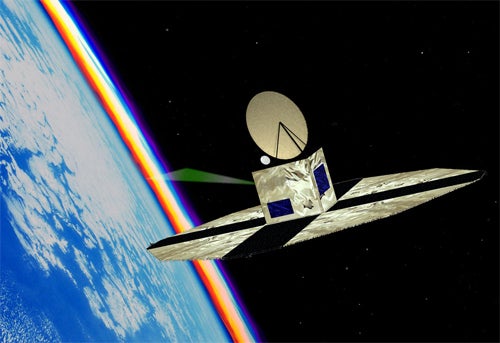A space telescope that can scan interstellar space for the radio fingerprints of complex molecules is giving astronomers their first-ever peek at the basic chemical ingredients that make up newborn stars. Equipped with tunable radio receivers, the Odin satellite has listened in on the famous Orion Nebula and discovered an entire cocktail of molecules including sulfur dioxide, ammonia, water, and many complex carbon compounds.
Launched into a 373-mile-high (600 kilometers) orbit in February 2001, Odin is an international mission led by Sweden, with Canada, France, and Finland as partners. Only the second sub-millimeter telescope in space, Odin is the first to have tunable receivers. Working like an AM/FM radio, it scans the unexplored bands of the electromagnetic spectrum tuning into very high frequencies of 500-600 GHz — about 1,000 times higher than the frequencies used in commercial television. Using the satellite like a giant radio dial, tuning in on newborn stars, astronomers expect to gain new insight on interstellar chemistry and physics.
“By compiling all this information, we hope gradually to build up a scenario of how stars and solar systems are formed,” says lead mission scientist Sun Kwok of the University of Calgary, who presented the findings last week at the annual meeting of the Canadian Astronomical Society in Montreal. “But the most exciting aspect of this study is the fact that most of this part of the electromagnetic spectrum has never been explored because much of it is invisible from the ground.”
Observations of celestial objects at such high frequencies are not possible from Earth-based radio telescopes because the moisture in the planet’s atmosphere naturally filters out most of the high-frequency radiation from space.
Odin team members chose the great Orion Nebula as their target because of its active star-forming region and its relative proximity to Earth, at 1,500 light-years away. Astronomers estimate this stellar nursery is filled will over 100 newborn stars, with some having formed protoplanetary disks, as observed by the Hubble Space Telescope.
According to Kwok, while the detection of abundant amounts of carbon compounds and water suggests some of the ingredients for life may be common in emission nebulae, one element was keenly missing in their scan of Orion: phosphorus. It is a key ingredient in the formation of DNA and other complex biological molecules, and the lack of phosphorus may hold significance in determining which star factories may have the right stuff for life. “Since we know phosphorus is so important in life-forming molecules and we could not find any, this finding may have an impact on how we relate molecules in space to life on Earth,” explains Kwok.
At the end of its career, Odin’s funding is running out, and it is slated for decommissioning in March 2006. However, this is not the end of astrochemistry research, as Europe’s Herschel Space Observatory will continue the search starting in February 2007.










